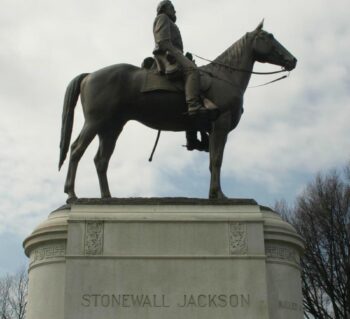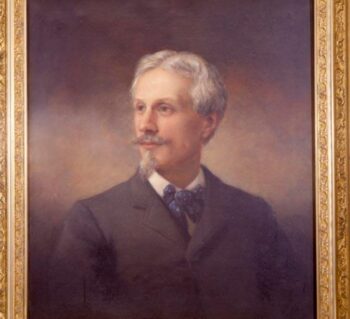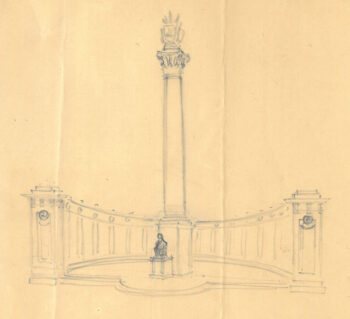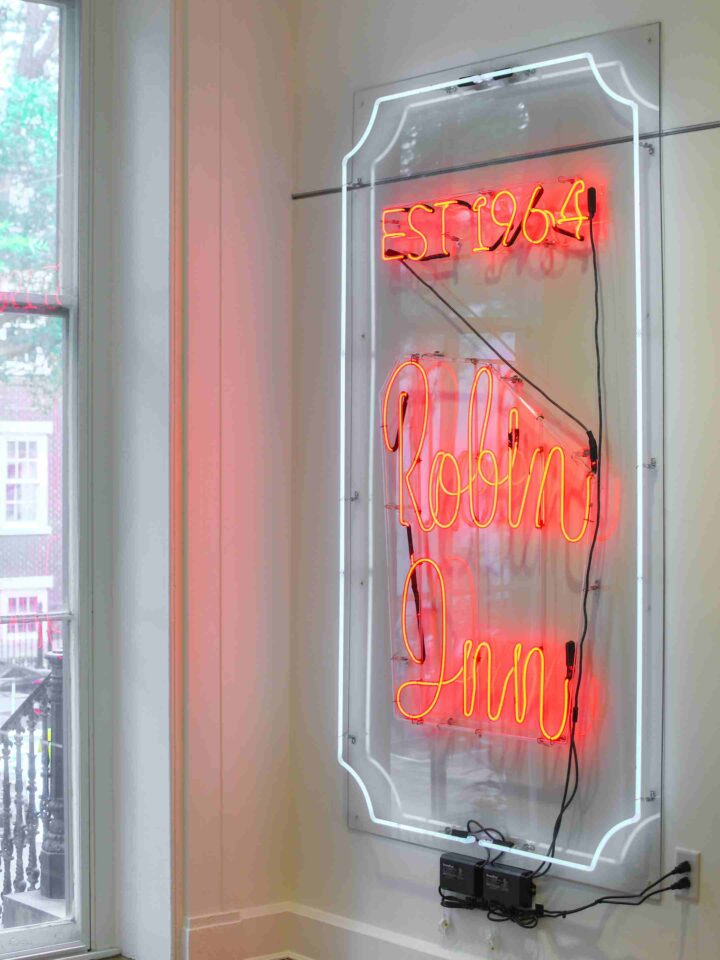
Monument Avenue: Robert. E. Lee Monument

It took nearly twenty years to erect a monument to Robert E. Lee in Richmond, and it came down in less than two.
By Christina K. Vida
Elisa H. Wright Curator of General Collections
Robert E. Lee died on October 12, 1870, in Lexington, Virginia. The following week, former Confederates Jubal Early and John Mosby organized a Lee Monument Association in Lexington, while the women of the Hollywood Memorial Association in Richmond established the Ladies’ Lee Monument Association. The two groups battled over the memory and monument to Robert E. Lee for the next twenty years.
By 1887, the groups had settled on a location in Richmond as well as a design for the equestrian monument by sculptor Marius-Jean-Antonin Mercié. On October 27, 1887, the Lee Monument Association with support from Freemasons laid the cornerstone for the monument on a circle of land at the intersection of Franklin and Allen streets.
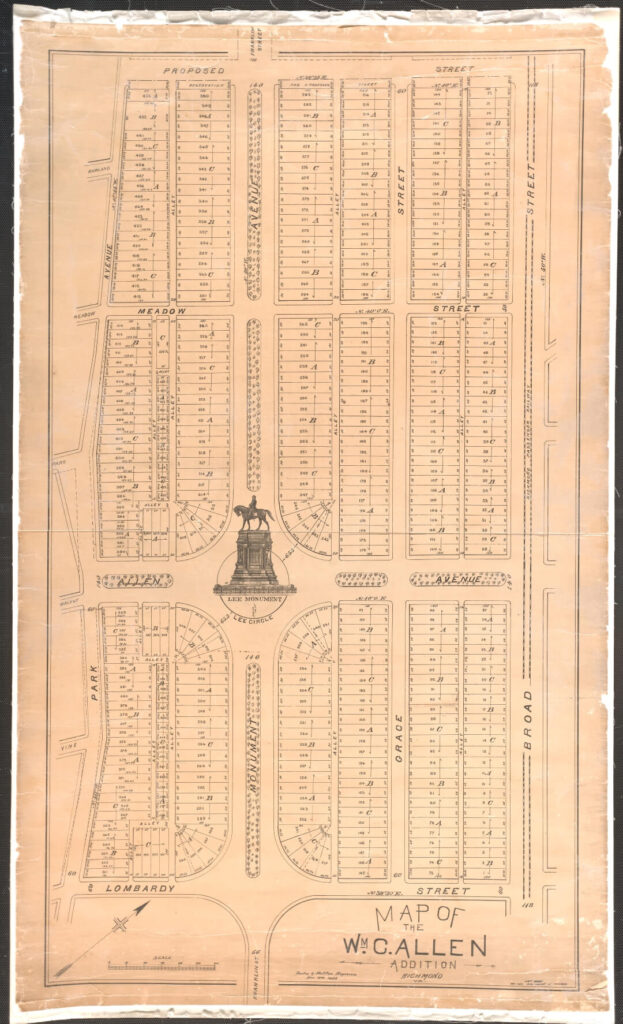
The first use of “Monument Avenue” to name this wide extension of Franklin Street occurred in the documents for the Allen family’s real estate development. James Netherwood and C.P.E. Burgwyn oversaw the construction of the Lee Monument for nearly three years.
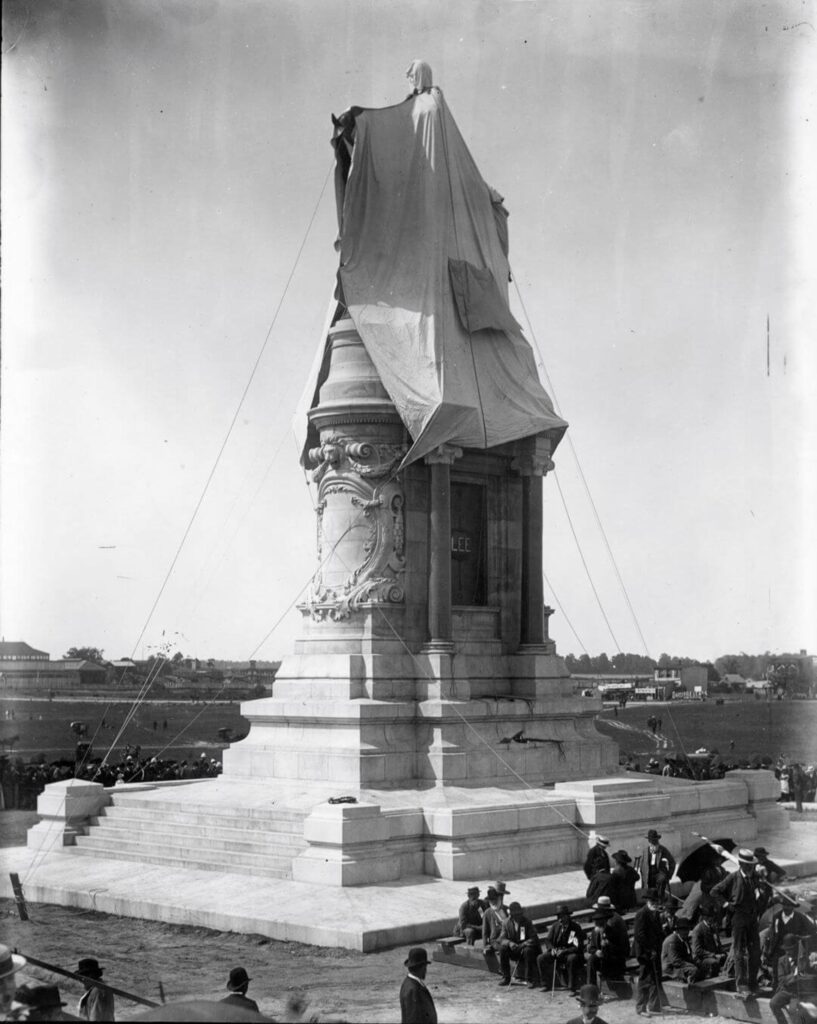
In the spring of 1890, children and citizens hauled the bronze components of the statue to the site with great fanfare, and Black workers then installed the equestrian statue on top of the pedestal. On May 29, 1890, Confederate General Joseph E. Johnston pulled the rope to unveil the Lee Monument to a massive crowd of supporters.
As a Black city councilman, John Mitchell, Jr., had voted ‘no’ to a city appropriation supporting the festivities around the Lee Monument, and as editor of the Richmond Planet, a Black weekly newspaper, he criticized the monument on the front page: “The South may revere the memory of its chieftains. It takes the wrong steps in so doing and proceeds to go too far in every similar celebration. Its servers to retard its progress in the county and forges heavier chains with which to be bound. All is over.”
During the 1900s and well into the 2000s, the Lee Monument served as the backdrop for Confederate celebrations and white supremacist gatherings. Owned by the Commonwealth of Virginia since 1890, the City of Richmond’s Monument Avenue Commission did not address the Lee Monument because it was not owned by the City and not within their scope of control.
An amendment to state law during the 2020 General Assembly session provided municipal governments with flexibility to remove war memorials and Confederate monuments, but debate continued over state-owned property like the Lee Monument.
On May 25, 2020, a Minneapolis police officer murdered George Floyd, sparking nationwide protests for social justice and police reform. In Richmond, symbols of the Confederacy became gathering places for activists, and protestors pulled down some in June 2020.
Over the summer of 2020, the amount of artwork and graffiti on the Lee Monument pedestal increased. Lee Circle in particular became a daytime convening space for community groups, mutual aid, and recreation while the nighttime brought on clashes between protestors and a heavily weaponized police force.
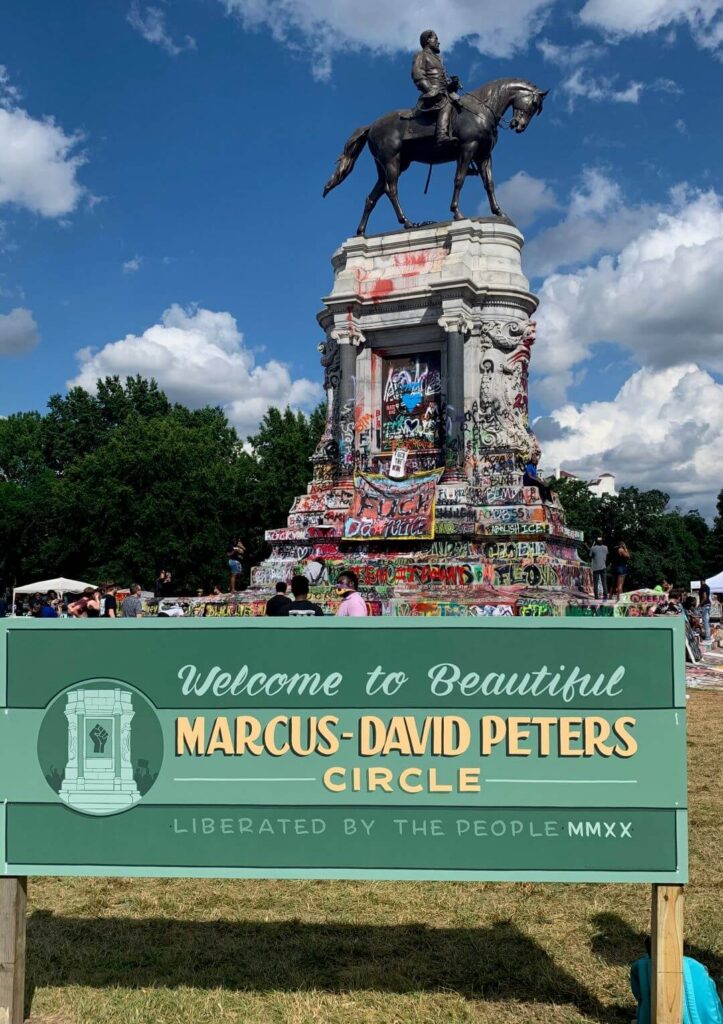
Community members renamed the space “Marcus-David Peters Circle” to remember an unarmed Richmond resident killed by police in 2018 while he was suffering a mental health incident. Activists added other memorials to victims of police violence, a community garden and basketball hoops.
In October 2020, the New York Times named the Lee Monument as the most influential piece of post-World War II protest art in the country.
Simultaneously in June 2020, Governor Ralph Northam’s administration was trying to remove the equestrian statue of Robert E. Lee from the Lee Monument. Officials had contacted Black contractor Devon Henry of Team Henry Enterprises to handle the removal, but they put plans on hold when multiple plaintiffs filed lawsuits against Northam and the administration.
After multiple rulings and appeals, the Supreme Court of Virginia ruled that the Commonwealth could proceed with the removal. On September 8, 2021, Team Henry Enterprises removed the bronze equestrian statue and relocated it to state property in Goochland County.
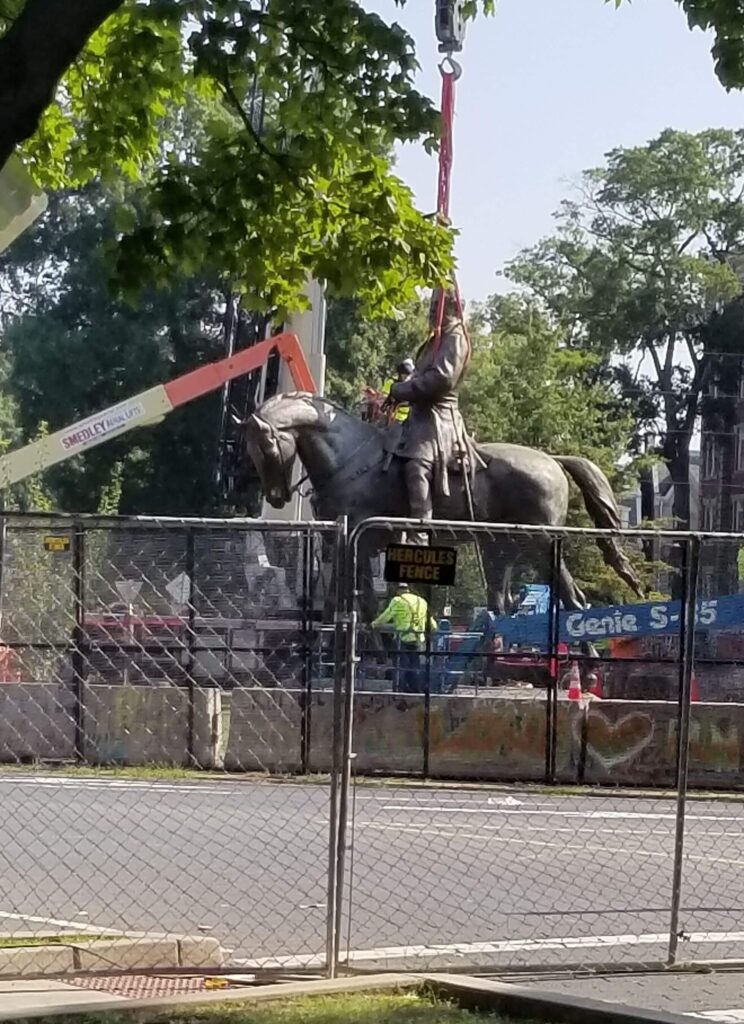
In November 2021, Republican candidate Glenn Youngkin won the campaign for Governor of Virginia. Between the election and Youngkin’s taking office in January 2022, the Northam administration hired Team Henry to remove the pedestal from Lee Circle, and then transferred the statue, pedestal pieces and the land itself to the City of Richmond.
Soon thereafter in 2022, the City of Richmond transferred all its Con ederate monuments to the Black History Museum & Cultural Center of Virginia. In 2022, the City of Richmond approved a “temporary” plan of plantings for the circle. Black-owned YME Landscape installed the plants and fencing, and barriers were removed in the summer of 2023.
The future use and public art installations on Lee Circle are now in the hands of the City of Richmond and its residents.
Sources
- Alexandria Gazette, October 19, 1870, pg. 2.
- “Monument to Lee in Richmond,” Daily Dispatch, October 25, 1870, pg 2.
- “Map Showing Site of Lee Monument,” Richmond Dispatch, October 23, 1887, pg. 6.
- “The Monument to Gen. Lee,” Richmond Dispatch, October 27, 1887, pg. 1.
- Richmond Dispatch, May 30, 1890, pgs. 1-2.
- “The Lee Monument Unveiling,” Richmond Planet, May 31, 1890, pg 1.
- John Mitchell, Jr., Richmond Planet, June 7, 1890, pg 2.
- American Civil War Museum, “Birth of Monument Avenue,” https://artsandculture.google.com/story/birth-of-monument-avenue-american-civil-war-museum/QgXhK5dKZ1esJA?hl=en.
- § 15.2-1812. Memorials for war veterans. Code of Virginia. https://www.nbc29.com/2020/04/12/northam-signs-bills-confederate-monuments-lgbtq-protections/
- Both the Lee Monument Association donated the monument and the land to the Commonwealth of Virginia on March 17, 1890. William Gregory v. Ralph Northam et al, Circuit Court for the City of Richmond, Complaint for Declaratory Judgement and Injunctive Relief, June 8, 2020, https://www.courthousenews.com/wp-content/uploads/2020/06/Lee-complaint.pdf.
- Matt Stevens, “For a Black Man Hired to Undo a Confederate Legacy, It Has Not Been Easy,” New York Times, April 17, 2022, updated June 22, 2023, https://www.nytimes.com/2022/04/17/arts/confederate-statue-removal-contractor.html.
- Denise Lavoie and Sarah Rankin, “Gen. Lee statue can be removed, Virginia Supreme Court rules,” AP News, September 2, 2021, https://apnews.com/article/courts-george-floyd-virginia-fa71756f4028936350a72d2e1a8cd4a1.
- “City Council authorizes mayor to accept Lee monument and land from state, “ Richmond Free Press, January 13, 2022, https://richmondfreepress.com/news/2022/jan/13/city-council-authorizes-mayor-accept-lee-monument-/.
- Caroline Janney, “Cornerstone Contributions: Where Are The Women?” Virginia Department of Historic Resources, April 13, 2022; https://www.dhr.virginia.gov/blog-posts/cornerstone-contributions-where-are-the-women/.
- John Salmon, “Cornerstone Contributions: Creating Monument Avenue,” Virginia Department of Historic Resources, May 11, 2022, https://www.dhr.virginia.gov/blog-posts/cornerstone-contributions-creating-monument-avenue/.
- Ervin L. Jordan, Jr., “Cornerstone Contributions: Black Richmonders, the Lee Monument, and the Lost Cause Redux,” Virginia Department of Historic Resources, June 9, 2022, https://www.dhr.virginia.gov/blog-posts/cornerstone-contributions-black-richmonders-the-lee-monument-and-the-lost-cause-redux/.
- Tannock Blair and D’mon Reynolds, “Residents react to new landscaping plans for former Lee Circle,” WRIC, October 4, 2022, https://www.wric.com/news/local-news/richmond/residents-react-to-new-landscaping-plans-for-former-lee-circle/.
- Thad Green, “Black-owned company begins to revitalize former Robert E. Lee monument site,” Richmond Times-Dispatch, June 2, 2023, https://richmond.com/news/local/black-owned-company-tasked-with-revitalizing-former-lee-site/article_295950de-fbf4-11ed-8dad-4369adce5714.html.
- Thad Green, “Fence comes down at Monument Avenue circle where Robert E. Lee statue once stood,” Richmond Times-Dispatch, August 29, 2023, https://richmond.com/news/local/monument-avenue-lee-circle-fencing-landscape/article_9d127c36-46a3-11ee-a8f5-4fb24af952c8.html.
Need to cite this?
| Authors | Christina K. Vida |
|---|---|
| Work Title | Monument Avenue: Robert. E. Lee Monument |
| Website | https://thevalentine.org |
| Published | September 14, 2023 |
| Updated | June 24, 2024 |
| Copyright | © 2024 The Valentine Museum |
